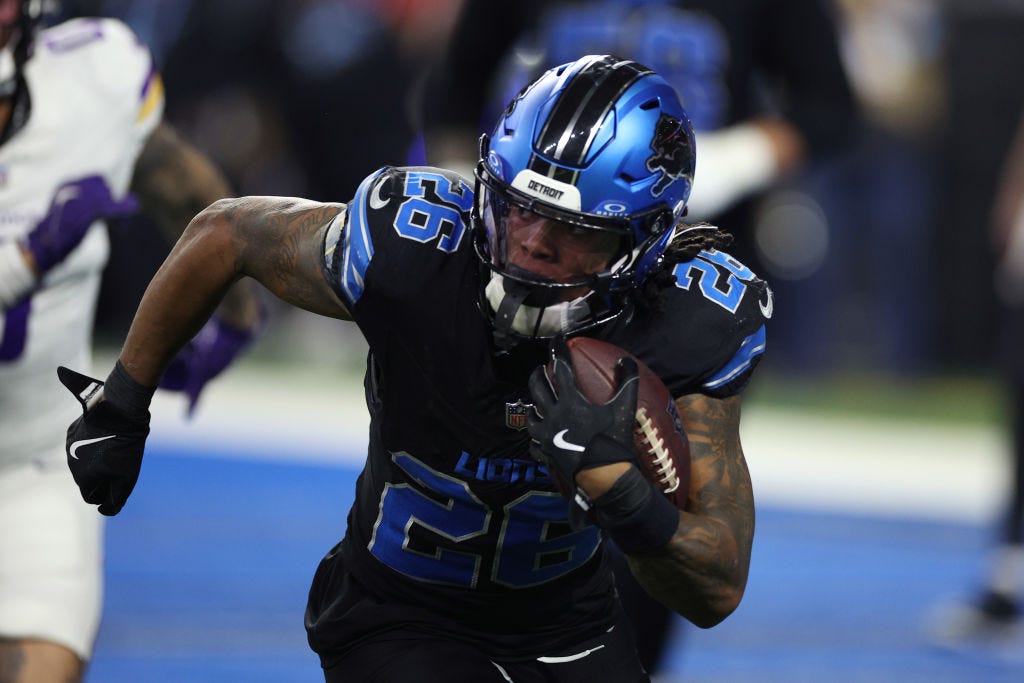Detroit Lions 2025 camp preview: Will o-line changes derail 4-year trend of ground game improvements?
Over the past couple of weeks, leading into the start of training camp, we've been taking a position-by-position look at the Detroit Lions' roster.
We’ve analyzed the projected starting situation, highlighted a key camp battle, explored a burning question, and set a statistical over/under for the upcoming season.
As we near the end of the series and the start of camp, today we’ll be looking at the running backs.
Who is on the roster?
Jahmyr Gibbs, David Montgomery, Craig Reynolds, Sione Vaki, Kye Robichaux, Anthony Tyus III
Starting lineup outlook
The Lions are blessed with one of the most talented and productive backfield tandems in NFL history. The duo of Montgomery and Gibbs combined for more than 3,000 yards from scrimmage in 2024 while averaging better than 5.0 yards per carry. The pair also found the end zone 32 times.
Montgomery continues to carry the starter tag. He was on the field for the first offensive snap in each of the 14 games that he wasn’t sidelined by an injury.
Gibbs, meanwhile, is unquestionably the more dynamic weapon. Earning Pro Bowl honors in his second season, he racked up 1,929 combined rushing and receiving yards, scored 20 times, and averaged 5.6 yards per carry.
In three late-season starts, Gibbs proved he's more than capable of shouldering a larger share of the pie. He tallied 487 yards from scrimmage and six touchdowns during that stretch. Regardless, even though that will only have fans and fantasy players clamoring for more of that type of workload this upcoming season, the Lions will push forward with a nearly even time split to ensure both backs are operating at maximum efficiency throughout the grueling regular season.
Camp competition to watch
Can anyone unseat Reynolds for the No. 3 job?
It’s not a particularly important role until there’s an injury. The veteran has averaged just 115 offensive snaps during his four seasons with the Lions. Still, when his number has been called, Reynolds has been reliable in all facets of the position.
Across those four seasons, he’s averaged 4.3 yards per carry, caught 24 of the 28 balls thrown his way, and been steady with his pass protection assignments.
As a rookie, Vaki proved to be considerably behind Reynolds on the depth chart outside of select two-minute situations. The gap will remain tough to close, and the same challenge exists for Robichaux and Tyus, two undrafted rookies. Reynolds’ impact on special teams only strengthens his hold on a roster spot.
A burning question
What more, if anything, can Vaki bring to the table in his second season?
The converted safety was predictably limited in his offensive role as a rookie, registering just 26 snaps, with nearly 40% of those coming in a blowout over Jacksonville.
Vaki’s primary contributions were on special teams, where he has tremendous value. Still, there’s a reason the Lions put him at running back despite most of his college playing time coming on defense. Vaki is dynamic with the ball in his hands, and it feels like a year in the system should lead to a handful more opportunities, particularly in the passing game, where he can flourish in space.
Setting an over/under
Team rushing average: 4.8 yards per carry
Under coach Dan Campbell, the Lions’ rushing average has been trending up for four straight seasons, going from 4.1 yards per attempt in 2020 to 4.7 per pop last season. That’s the best figure since Barry Sanders’ 2,000-yard season in 1997.
Detroit’s commitment to the run isn’t about to change, and the team has added some young interior talent with reputations for being maulers. Oh, and did you hear that All-Pro right tackle Penei Sewell’s offseason focus has been on getting bigger and stronger?
Look, the blocking is going to need to iron out its chemistry with the new pieces, particularly following the retirement of All-Pro center Frank Ragnow, but with Montgomery’s consistency and Gibbs’ big-play potential, Detroit’s backs can continue the upward trend.



I am going under. It won't be a huge drop but I don't see them getting even better with the OL being a question mark. Maybe by years end they are cranking at 4.8 or better.
The one cavate is the lions will likely be playing behind more often with that schedule so less 4-minute offense that tends to be lower yards per rush. More Gibbs too.
The pass and run games are very complementary. With Jamo, the defense has to respect the deep ball and play safeties deeper. Just look at tape from last year. Safeties are playing 12-15 yards off when normally they play at 10-12. That’s the effect of speed. That means safeties are slower to fill and backs have an easier time finding a crease. In addition, with Amon Ra and LaPorta, linebackers and nickels have to play looser. That gives the O-line a better chance to get to them. I’ll take the over.